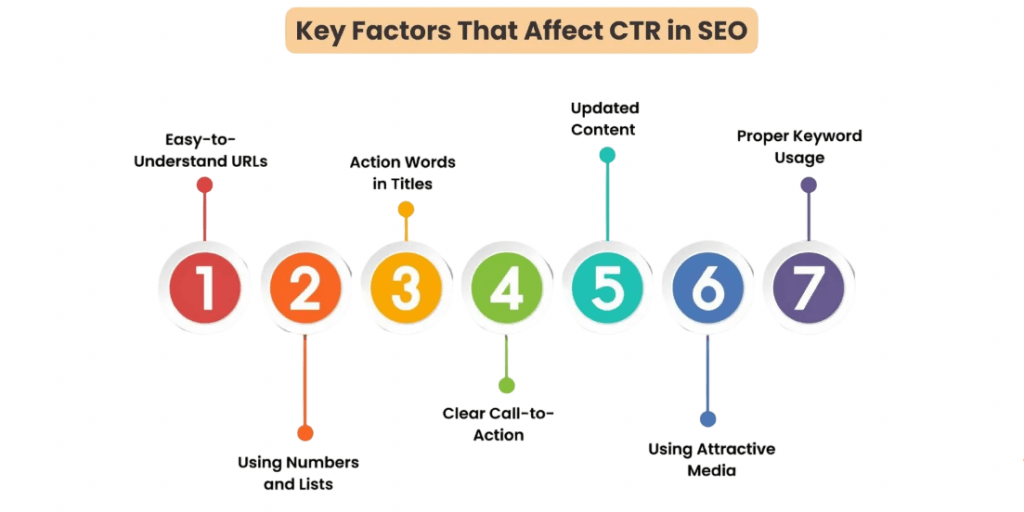
- Introduction
- Defining Click-Through Rate: What Does It Mean?
- Why is CTR Important in Digital Marketing?
- How to Calculate CTR
- Different Types of CTR
- Factors That Influence CTR
- How to Improve Your CTR
- CTR Benchmarks Across Channels
- CTR vs Other Key Metrics
- Conclusion
Introduction
In digital marketing, understanding user behavior and campaign effectiveness is crucial. Among the key metrics marketers monitor is CTR, or Click-Through Rate. This metric helps measure how well your ads, emails, or web content are engaging your audience and driving traffic. In this guide, we will explore Click-Through Rate and its role in digital marketing. We will explain how to calculate CTR, so you clearly understand how this metric is determined a foundational concept covered in Digital Marketing Training, where learners use the formula CTR = (Clicks ÷ Impressions) × 100 to evaluate ad performance, optimize campaigns, and interpret user engagement across digital channels. Additionally, we will share various strategies and best practices to improve your CTR, helping you optimize your campaigns for better results. Finally, we will look at how CTR fits into your overall marketing strategy, connecting it with your goals and objectives to create a unified approach that drives results. Through this exploration, you will gain valuable knowledge to make better decisions and enhance your digital marketing efforts.
Ready to Get Certified in Digital Marketing? Explore the Program Now Digital Marketing Online Training Offered By ACTE Right Now!
Defining Click-Through Rate: What Does It Mean?
CTR (Click-Through Rate) is the ratio of users who click on a specific link or ad to the total number of users who view that link or ad (impressions). In simple terms, CTR shows how many people saw your content and chose to interact by clicking on it. This metric is an important sign of how well your online marketing efforts are working. It provides valuable insights into user engagement and the overall performance of your campaigns critical competencies developed in Become a Marketing Manager, where professionals learn to interpret campaign analytics, optimize engagement strategies, and align performance metrics with business objectives to drive measurable success. A higher CTR often means that your content resonates well with your target audience and encourages them to take action. On the other hand, a low CTR might suggest that your messaging, visuals, or targeting strategies need improvement to better capture the interest of potential customers. Understanding and looking at CTR can help marketers refine their strategies, improve their content, and ultimately drive more traffic to their websites or landing pages. This can lead to increased conversions and a better return on investment (ROI). By consistently monitoring and adjusting your approach based on CTR data, you can improve your online presence and meet your business goals more effectively.
Why is CTR Important in Digital Marketing?
CTR is a direct indicator of engagement and relevance. A higher CTR suggests that your message resonates with your audience, and your content or ads are compelling enough to prompt action performance signals explored in What are the Types of Content Marketing, where marketers learn to match content formats with audience intent, optimize messaging for clicks, and evaluate engagement across blogs, videos, infographics, and more.
Key reasons CTR matters:
- Measures Effectiveness: Reveals how well your campaign captures attention.
- Improves Quality Scores: In platforms like Google Ads, a higher CTR can reduce costs and improve ad placement.
- Drives Traffic: More clicks mean more visitors to your website or landing page.
- Optimizes ROI: Helps identify which ads or content perform best, improving budget allocation.
- Insights for Improvement: Low CTR signals the need for better targeting or creative elements.
- Clicks = Number of times users clicked the ad or link.
- Impressions = Number of times the ad or link was shown.
- CTR=(501000)×100=5%\text{CTR} = \left(\frac{50}{1000}\right) \times 100 = 5\%CTR=(100050)×100=5%
To Explore Digital Marketing in Depth, Check Out Our Comprehensive Digital Marketing Online Training To Gain Insights From Our Experts!
How to Calculate CTR
The formula for CTR is:
For example, if your ad was shown 1,000 times and received 50 clicks:
Different Types of CTR
Click-through rate (CTR) is a useful metric that provides important insights into various types of CTR in digital marketing channels. Advertisers measure performance using different specific metrics. For example, ad CTR calculates clicks on paid search or display ads in relation to total impressions a core metric analyzed in Digital Marketing Training, where learners explore CTR benchmarks, optimize ad creatives, and align campaign strategies with measurable engagement across paid media channels. They also look at email CTR to gauge how well links perform in email campaigns by comparing clicks to the total messages sent. Similarly, marketers check organic CTR to see how effective search result listings are by looking at clicks compared to total search appearances. Social media CTR allows them to track how users interact with posts and ads by comparing clicks to total impressions. Each channel has its own benchmarks and factors to consider, helping marketers create detailed strategies that improve digital engagement and understand audience behavior on different platforms.
Looking to Digital Marketing Training? Discover the Digital Marketing Expert Masters Program Training Course Available at ACTE Now!
Factors That Influence CTR
Click-through rates (CTR) depend on various strategic elements that marketers need to consider carefully. The relevance of an ad or content to a user’s intent is a key driver of engagement. It directly affects how likely viewers are to interact. The quality of ad copy and content is also crucial factors shaped by Understanding Google Algorithm Updates, where marketers learn how changes in ranking criteria prioritize relevance, user intent, and content quality to drive engagement and improve visibility across search platforms.

They should have clear, compelling messages and persuasive calls-to-action that appeal to the target audience. Visual appeal matters too. Attention-grabbing images, videos, and graphics are effective tools for engagement. Targeting the right audience ensures that ads reach the most responsive demographic. The placement of ads in search results or social feeds can significantly improve visibility. Understanding how users behave on different devices is important. Mobile and desktop users may react in different ways. Staying aware of the competitive landscape is essential as well. Increased advertising density can reduce the performance of individual ads and lower overall click-through rates.
How to Improve Your CTR
- Craft Compelling Headlines and CTAs: Make your offer clear and enticing.
- Use Relevant Keywords: Ensure your content matches searcher intent.
- Test Ad Variations (A/B Testing): Try different headlines, images, or CTAs.
- Improve Targeting: Use demographics, interests, and behavior to refine your audience.
- Leverage Ad Extensions: In platforms like Google Ads, use sitelinks, callouts, and structured snippets.
- Optimize Landing Pages: Ensure consistency and relevance to maintain user interest.
- Use Numbers and Emotional Triggers: They capture attention better.
- Include Strong Visuals: Images and videos improve engagement.

Preparing for Digital Marketing Job Interviews? Have a Look at Our Blog on Digital Marketing Interview Questions and Answers To Ace Your Interview!
CTR Benchmarks Across Channels
CTR Benchmarks vary by industry, platform, and campaign type. Approximate averages include metrics that are foundational to strategic planning in Digital Marketing Career Guide, where learners explore how click-through rates reflect audience engagement across channels like email, search, and social media. Understanding benchmark variations helps marketers set realistic goals, optimize ad creatives, and improve ROI through data-driven adjustments.
| Channel | Average CTR |
|---|---|
| Google Search Ads | 3-5% |
| Display Ads | 0.5-1% |
| Facebook Ads | 0.9-1.6% |
| Email Marketing | 2-5% |
| Organic Search | Varies widely, often 2-10% depending on position |
CTR Benchmarks are useful guides but always compare against your own historical data.
CTR vs Other Key Metrics
In digital marketing metrics, marketers need to grasp the relationships between Click-Through Rate (CTR), conversion rate, and other important performance indicators to improve campaign effectiveness. CTR counts the clicks an ad gets, while conversion rate looks at the percentage of those clicks that lead to actions like sales or sign-ups essential performance metrics explored in Tips To Learn Digital Marketing, where learners distinguish between engagement and conversion, apply optimization strategies, and align ad performance with business outcomes for measurable growth. A higher CTR can often lead to a lower Cost Per Click (CPC) in paid advertising. This makes it an essential factor for campaign efficiency. However, marketers should be careful. A high CTR with a high bounce rate could indicate problems such as misleading ad content or ineffective landing page design. This can hurt the overall performance of the campaign and its potential return on investment.
Conclusion
CTR is a key metric in digital marketing that measures how well your content or ads engage your audience. By monitoring and improving your CTR, you can increase traffic, get better ROI, and strengthen brand performance. Understanding CTR’s role and using data-driven strategies to improve it, while also connecting it with your overall marketing goals, helps you optimize your campaigns for greater success an integrated approach emphasized in Digital Marketing Training, where learners align click-through metrics with strategic objectives, apply performance insights, and refine campaign execution for measurable impact across digital channels. This process involves looking at the factors that lead to a higher CTR, such as creating compelling headlines, designing eye-catching visuals, and targeting specific audience segments. Conducting A/B testing on different ad formats and messages gives you insights into what resonates with your audience, allowing you to refine your approach continuously. Also, think about the user journey beyond just the click. Making sure the landing page experience matches the expectations set by the ad can greatly improve conversion rates. Ultimately, taking a broader view of CTR along with other performance metrics helps you build more meaningful connections with your audience, fostering loyalty and driving sustained growth for your brand in the competitive digital landscape.




